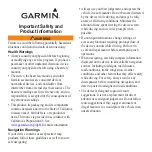
26
OPERATION
Successful Tracking
As with any tracking device or tracking mission there are multiple issues that
can either make or break the success of the mission. Experience with the
tracking equipment and familiarity with the fundamental principles in
tracking are essential.
This section is designed to familiarize you with the E-TRAK/R PDA Control
Head display, its functions, and how to read the graphical representations.
Knowing how to interpret this information can help keep you on track.
Issues regarding general tracking techniques, multipath reflections and
environmental conditions are covered starting on page 28.
The PDA Control Head provides you with real-time information regarding
received data including signal strength, movement of beacon, direction of
received RF signals and relative direction of GPS coordinates between the
beacon and the tracking vehicle. At times the collective data presented in this
literal format may seem ambiguous. Variables like speed of vehicles, changes
in direction, proximity, and availability of satellite access need to be inter-
preted by an experienced operator. Following are several examples to help you
understand and predict your course of action during a tracking mission.
General practices:
• When tracking, stay close enough to keep the received signal strength
indicator above half-scale.
• Maintain closer following distance in hilly terrain.
• Avoid low-lying areas while tracking - try to get to higher ground
quickly if contact with beacon is temporarily lost.
• Approach intersections carefully to avoid missing turns due to update
time lapse.
• Command transmitter functions are more reliable when both the
E-TRAK/R and beacon are stationary.
The effective range of the E-TRAK/R
system may depend upon:
• On channel or adjacent
channel interference
• Ambient RF noise level
• Electrical or vehicular ignition
noise
• Topographic features, such as
hills and valleys
• The radiating pattern of the
beacon (a function of beacon
location on the target vehicle)
• The populous of the area
• Presence and alignment of
large buildings
• Density of heavily wooded
areas
• Traffic density and patterns
• The presence of large trucks
• Road conditions (overpasses,
underpasses, bridges, tun-
nels)
• Proximity to large bodies of
water
Summary of Contents for 5000
Page 1: ...RDF Pulse and GPS Enhanced Tracking System...
Page 29: ...35 NOTES...










































